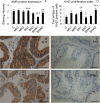Hypothermia and rewarming induce gene expression and multiplication of cells in healthy rat prostate tissue
- PMID: 25996932
- PMCID: PMC4440734
- DOI: 10.1371/journal.pone.0127854
Hypothermia and rewarming induce gene expression and multiplication of cells in healthy rat prostate tissue
Erratum in
-
Correction: Hypothermia and Rewarming Induce Gene Expression and Multiplication of Cells in Healthy Rat Prostate Tissue.PLoS One. 2015 Jun 12;10(6):e0131261. doi: 10.1371/journal.pone.0131261. eCollection 2015. PLoS One. 2015. PMID: 26066324 Free PMC article. No abstract available.
-
Correction: Correction: Hypothermia and Rewarming Induce Gene Expression and Multiplication of Cells in Healthy Rat Prostate Tissue.PLoS One. 2015 Aug 25;10(8):e0137228. doi: 10.1371/journal.pone.0137228. eCollection 2015. PLoS One. 2015. PMID: 26305783 Free PMC article. No abstract available.
Abstract
Prostate cancer has been extensively studied, but cellular stress responses in healthy prostate tissue are rarely investigated. Hypothermia is known to cause alterations in mRNA and protein expressions and stability. The aim of this study was to use normal rat prostate as a model in order to find out consequences of cold exposure and rewarming on the expressions of genes which are either members or functionally/structurally related to erythroblastic leukemia viral oncogene B (ErbB) signaling pathway. Relative mRNA expressions of amphiregulin (AMR), cyclin D1 (CyD1), cyclin-dependent kinase inhibitor 1A (p21), transmembrane form of the prostatic acid phosphatase (PAcP), thrombomodulin (TM) and heat shock transcription factor 1 (HSF1) in rat ventral prostate were quantified in mild (2 or 4.5 h at room temperature) and severe (2 or 4.5 h at +10°C) hypothermia and in rewarming after cold exposure (2 h at +10°C followed by 2 h at room temperature or 3 h at +28°C). AMR protein level, apoptotic Bcl-2 associated X protein to B-cell CLL/lymphoma 2 (Bax/Bcl-2) mRNA ratio and proliferative index Ki-67 were determined. 4.5-h mild hypothermia, 2-h severe hypothermia and rewarming increased expression of all these genes. Elevated proliferation index Ki-67 could be seen in 2-h severe hypothermia, and the proliferation index had its highest value in longer rewarming with totally recovered normal body temperature. Pro-apoptotic tendency could be seen in 2-h mild hypothermia while anti-apoptosis was predominant in 4.5-h mild hypothermia and in shorter rewarming with only partly recovered body temperature. Hypothermia and following rewarming promote the proliferation of cells in healthy rat prostate tissue possibly via ErbB signaling pathway.
Conflict of interest statement
Figures



Similar articles
-
Changes in cardiac thrombomodulin and heat shock transcription factor 1 expression and peripheral thrombomodulin and catecholamines during hypothermia in rats.Stress. 2014 Dec;17(6):504-11. doi: 10.3109/10253890.2014.953477. Stress. 2014. PMID: 25109347
-
Myocardial gene expression profiling of rewarming shock in a rodent model of accidental hypothermia.Cryobiology. 2012 Jun;64(3):201-10. doi: 10.1016/j.cryobiol.2012.01.009. Epub 2012 Jan 31. Cryobiology. 2012. PMID: 22330979
-
An elevated bax/bcl-2 ratio corresponds with the onset of prostate epithelial cell apoptosis.Cell Death Differ. 1999 Jan;6(1):48-54. doi: 10.1038/sj.cdd.4400453. Cell Death Differ. 1999. PMID: 10200547
-
[Pre-hospital rewarming methods for hypothermia casualties].Harefuah. 2003 Nov;142(11):780-5, 804. Harefuah. 2003. PMID: 14631912 Review. Hebrew.
-
[Accidental hypothermia in multiple trauma patients].Zentralbl Chir. 2012 Jun;137(3):264-9. doi: 10.1055/s-0030-1262604. Epub 2011 Feb 28. Zentralbl Chir. 2012. PMID: 21360427 Review. German.
Cited by
-
RNU6B, a frequent reference in miRNA expression studies, differentiates between deaths caused by hypothermia and chronic cardiac ischemia.Int J Legal Med. 2020 Jan;134(1):159-162. doi: 10.1007/s00414-019-02041-0. Epub 2019 Mar 23. Int J Legal Med. 2020. PMID: 30904931 Free PMC article.
-
Effects of temperature on proliferation of myoblasts from donor piglets with different thermoregulatory maturities.BMC Mol Cell Biol. 2021 Jun 26;22(1):36. doi: 10.1186/s12860-021-00376-4. BMC Mol Cell Biol. 2021. PMID: 34174812 Free PMC article.
-
Magnolol pretreatment attenuates heat stress-induced IEC-6 cell injury.J Zhejiang Univ Sci B. 2016 Jun;17(6):413-24. doi: 10.1631/jzus.B1500261. J Zhejiang Univ Sci B. 2016. PMID: 27256675 Free PMC article.
-
Amphiregulin is overexpressed in human cardiac tissue in hypothermia deaths; associations between the transcript and stress hormone levels in cardiac deaths.Ann Med. 2024 Dec;56(1):2420862. doi: 10.1080/07853890.2024.2420862. Epub 2024 Nov 7. Ann Med. 2024. PMID: 39506618 Free PMC article.
-
Correction: Hypothermia and Rewarming Induce Gene Expression and Multiplication of Cells in Healthy Rat Prostate Tissue.PLoS One. 2015 Jun 12;10(6):e0131261. doi: 10.1371/journal.pone.0131261. eCollection 2015. PLoS One. 2015. PMID: 26066324 Free PMC article. No abstract available.
References
-
- Sonna LA, Fujita J, Gaffin SL, Lilly CM. Effects of heat and cold stress on mammalian gene expression. J Appl Physiol. 2002;92: 1725–1742. - PubMed
-
- Harris RC, Chung E, Coffey RJ. EGF receptor ligands. Exp Cell Res. 2003;284: 2–13. - PubMed
-
- Shoyab M, Plowman GD, McDonald VL, Bradley JG, Todaro GJ. Structure and function of human amphiregulin: a member of the epidermal growth factor family. Science. 1989;243: 1074–1976. - PubMed
MeSH terms
Substances
LinkOut - more resources
Full Text Sources
Other Literature Sources
Medical
Research Materials
Miscellaneous

